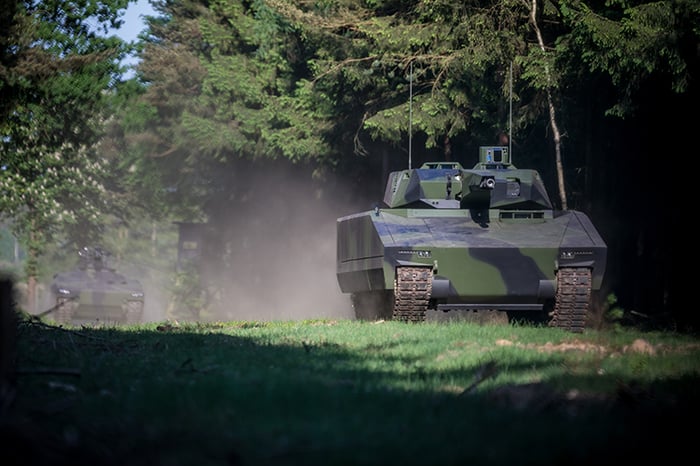The U.S. Army has pulled the plug on its planned $45 billion competition to replace its mainstay Bradley Fighting Vehicle, deciding instead to go back to the drawing board and rework what it is looking for in a new armored vehicle.
The decision is a setback for General Dynamics (GD 0.28%), which was the last remaining bidder in the now-canceled Optionally Manned Fighting Vehicle (OMFV) competition. But it could also present an opportunity for BAE Systems (BAES.Y -2.50%) or even Raytheon (RTN) to jump back into the competition.
This is the third time since 2009 that the Army's attempt to replace the Bradley has ended in cancellation. This latest effort was run by the Army's new Futures Command, a unit established in 2018 to help speed hardware modernization. But speed ultimately killed the OMFV effort. And the industry is now left waiting to hear how the Army wants to proceed next.

General Dynamics' OMFV entry was believed to be modeled around its Griffin II prototype. Image source: General Dynamics.
"The Army asked for a great deal of capability on a very aggressive schedule," Bruce Jette, Assistant Secretary of the Army for Acquisition, Logistics and Technology, said in a statement announcing the cancellation. "Despite an unprecedented number of industry days and engagements ... it is clear a combination of requirements and schedule overwhelmed industry's ability to respond within the Army's timeline."
A long, drawn-out battle
The Army seemingly can't avoid drama when it goes shopping for armored vehicles. The development of the Bradley was marred by cost overruns and controversy, eventually inspiring a critical book and the 1998 HBO movie The Pentagon Wars.
The Army went into this latest competition demanding a future-proof vehicle eventually capable of driving autonomously, while on a breakneck schedule that would see the winner in the field as early as 2026. The Army had earmarked about $2 billion for research and development, and about $43 billion to acquire 3,800 vehicles.
BAE Systems, maker of the current Bradley and viewed as among the favorites going into the bidding to replace the vehicle, last June surprised watchers by backing out of the competition due to "the requirements and schedule." Another potential bidder, South Korea's Hanwha, according to reports dropped out after seeing the requirements.
That set up a two-vehicle race between GD and a joint bid by Raytheon and German defense conglomerate Rheinmetall (RNMBY -4.12%), but the Raytheon team was disqualified just days after the Oct. 1 deadline to submit candidates. While details remain unclear, it appears the disqualification occurred at least in part because Rheinmetall was unable to transport its Lynx vehicle prototype from its facility in Germany to the Army's Aberdeen (Maryland) Proving Ground in time.
What now?
In one sense, the reboot shows the Army's Futures Command is working as intended. In 2018, when the unit was established, Army Secretary Ryan D. McCarthy said the goal was, in part, that "if you fail, we'd like you to fail early and fail cheap." If the Army wasn't pleased with how the competition had played out, better to scrap it early rather than spend millions more on testing or end up with a vehicle in production that doesn't meet requirements.
The Army now faces the challenge of reworking its requirements in hopes of attracting additional submissions, while not compromising on its goal of future-proofing the new vehicle. It is unclear whether Army evaluators considered the General Dynamics OMFV submission to be adequate, but the decision to restart the process would imply there is no clear front-runner at this point.

Rheinmetall was unable to get its Lynx vehicle to Maryland in time to compete. Will the company rejoin the competition? Image source: Rheinmetall.
"The most prudent means of ensuring long-term programmatic success is to get this multi-billion-dollar effort correct," Gen. John M. Murray, commander of Army Futures Command, said in the statement announcing the decision. "We are going to take what we have learned and apply it to the OMFV program to develop our path and build a healthy level of competition back into the program."
It's worth noting that the Pentagon appears comfortable with having only one bidder for other programs: Huntington Ingalls, for example, is the nation's only manufacturer of aircraft carriers, and Northrop Grumman is currently the only candidate in the running to build the nation's new intercontinental ballistic missile. The cancellation could suggest that either General Dynamics was not able to deliver on the OMFV requirements, or the Army set the bar too high for any company to satisfy.
Fight another day
It's hard not to see this decision as a setback for General Dynamics. It relies on land equipment contracts more than any other major defense company. And while GD is involved in several other competitions, including a battle to produce the Army's new light tank, General Dynamics needs to win as many of these deals as possible to generate strong growth from its defense portfolio.
Of course, General Dynamics will be among the companies to watch in the rebooted competition, regardless of what the Army puts forward in terms of requirements, and it remains to be seen how many other vendors decide to rejoin the competition. This could still end up a win for GD.
The Army needs to figure out exactly what it wants, and what is possible, for its new fighting vehicle. Until then the industry, and investors, are in a holding pattern waiting to see what comes next.





